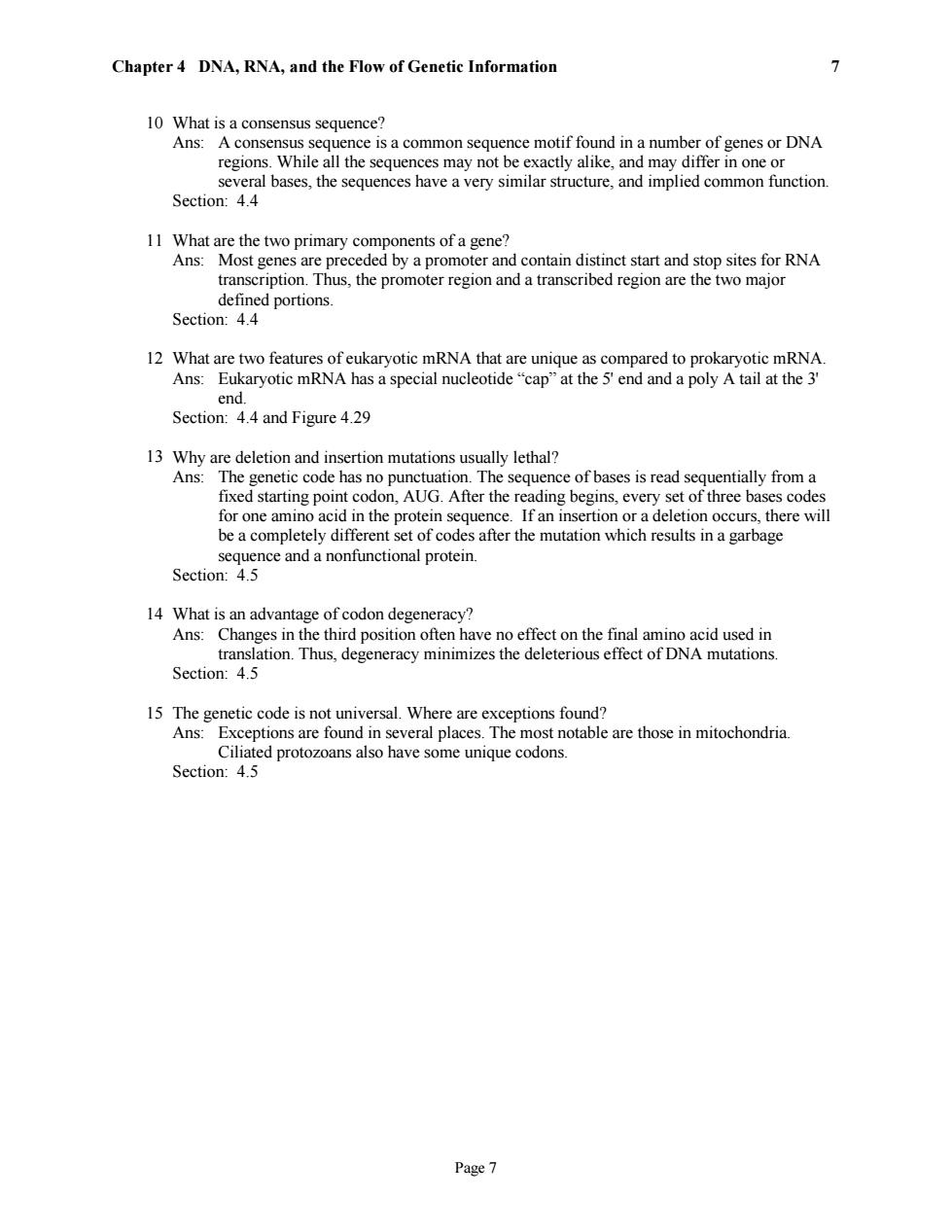正在加载图片...

Chapter 4 DNA,RNA,and the Flow of Genetic Information 7 10 What is a consensus sequence? Ans:A consensus sequence is a common sequence motif found in a number of genes or DNA regions.While all the sequences may not be exactly alike,and may differ in one or several bases,the sequences have a very similar structure,and implied common function. Section:4.4 11 What are the two primary components of a gene? Ans:Most genes are preceded by a promoter and contain distinct start and stop sites for RNA transcription.Thus,the promoter region and a transcribed region are the two major defined portions. Section:4.4 12 What are two features of eukaryotic mRNA that are unique as compared to prokaryotic mRNA. Ans:Eukaryotic mRNA has a special nucleotide"cap"at the 5'end and a poly A tail at the 3' end. Section:4.4 and Figure 4.29 13 Why are deletion and insertion mutations usually lethal? Ans:The genetic code has no punctuation.The sequence of bases is read sequentially from a fixed starting point codon,AUG.After the reading begins,every set of three bases codes for one amino acid in the protein sequence.If an insertion or a deletion occurs,there will be a completely different set of codes after the mutation which results in a garbage sequence and a nonfunctional protein. Section:4.5 14 What is an advantage of codon degeneracy? Ans:Changes in the third position often have no effect on the final amino acid used in translation.Thus,degeneracy minimizes the deleterious effect of DNA mutations. Section:4.5 15 The genetic code is not universal.Where are exceptions found? Ans:Exceptions are found in several places.The most notable are those in mitochondria. Ciliated protozoans also have some unique codons. Section:4.5 Page 7Chapter 4 DNA, RNA, and the Flow of Genetic Information Page 7 7 10 What is a consensus sequence? Ans: A consensus sequence is a common sequence motif found in a number of genes or DNA regions. While all the sequences may not be exactly alike, and may differ in one or several bases, the sequences have a very similar structure, and implied common function. Section: 4.4 11 What are the two primary components of a gene? Ans: Most genes are preceded by a promoter and contain distinct start and stop sites for RNA transcription. Thus, the promoter region and a transcribed region are the two major defined portions. Section: 4.4 12 What are two features of eukaryotic mRNA that are unique as compared to prokaryotic mRNA. Ans: Eukaryotic mRNA has a special nucleotide “cap” at the 5' end and a poly A tail at the 3' end. Section: 4.4 and Figure 4.29 13 Why are deletion and insertion mutations usually lethal? Ans: The genetic code has no punctuation. The sequence of bases is read sequentially from a fixed starting point codon, AUG. After the reading begins, every set of three bases codes for one amino acid in the protein sequence. If an insertion or a deletion occurs, there will be a completely different set of codes after the mutation which results in a garbage sequence and a nonfunctional protein. Section: 4.5 14 What is an advantage of codon degeneracy? Ans: Changes in the third position often have no effect on the final amino acid used in translation. Thus, degeneracy minimizes the deleterious effect of DNA mutations. Section: 4.5 15 The genetic code is not universal. Where are exceptions found? Ans: Exceptions are found in several places. The most notable are those in mitochondria. Ciliated protozoans also have some unique codons. Section: 4.5